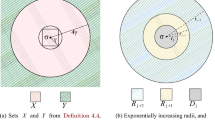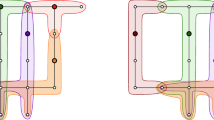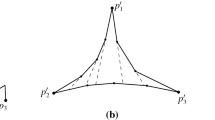Abstract
We provide an \(O(n \,\hbox {polylog}\, n)\) bound on the expected complexity of the randomly weighted multiplicative Voronoi diagram of a set of \(n\) sites in the plane, where the sites can be either points, interior disjoint convex sets, or other more general objects. Here the randomness is on the weight of the sites, not on their location. This compares favorably with the worst-case complexity of these diagrams, which is quadratic. As a consequence we get an alternative proof to that of Agarwal et al. (Discrete Comput Geom 54:551–582, 2014) of the near linear complexity of the union of randomly expanded disjoint segments or convex sets (with an improved bound on the latter). The technique we develop is elegant and should be applicable to other problems.

Similar content being viewed by others
Notes
That is, under the stereographic projection of the plane to the sphere, the bisector is a simple closed Jordan curve through the north pole.
One can assume that the bisectors contain no vertical segments, since otherwise we can slightly rotate the plane, and hence extremal points are well defined.
Specifically, for every site \({s}\) generate, in addition to its weight \(\omega \) chosen from \(\xi \), a secondary weight \(\omega '\) which is picked uniformly at random from the interval \([0,1]\). Now order the sites in lexicographic ordering of the pairs \((\omega , \omega ')\).
A formal proof of this is somewhat tedious. Indeed, given \(y_{t}, \cdots , y_n\), let \(\Bigl . F_{t} = F_{t}({ y_{t}, \ldots , y_n}) = \{ { \langle {\pi _1,\ldots , \pi _n} \rangle | \pi _{t} = y_{t}, \pi _{t+1} = y_{t+1}, \ldots , \pi _{n} = y_{n}} \}\) denote the suffix event, where the specific values of the \(\pi _{t},\ldots , \pi _n\) are fully specified. By the above, we have \({\mathbf {Pr}}[ \bigl . \mathcal {E}_{i_1} | F_{i_1+1}] = 1/i_1\). Observe that the event \(\mathcal {E}_{i_2} \cap \cdots \cap \mathcal {E}_{i_k}\) is the disjoint union of suffix events. Indeed, for a specific value of \(y_{i_2},\ldots , y_n\), either all the permutations of \(F_{i_2}(y_{i_2},\ldots , y_n)\) or none are in \(\mathcal {E}_{i_2} \cap \cdots \cap \mathcal {E}_{i_k}\). As such, let \(\mathcal {F}\) be the set of all the suffix events that are in \(\mathcal {E}_{i_2} \cap \cdots \cap \mathcal {E}_{i_k}\). Now, we have \({\mathbf {Pr}}[\mathcal {E}_{i_1} | \mathcal {E}_{i_2} \cap \cdots \cap \mathcal {E}_{i_k} ] = \sum _{F\in \mathcal {F}} {\mathbf {Pr}}[ \mathcal {E}_{i_1} | F] {\mathbf {Pr}}[F| \mathcal {E}_{i_2} \cap \cdots \cap \mathcal {E}_{i_k}] = \sum _{F\in \mathcal {F}} {\mathbf {Pr}}[\mathcal {E}_{i_1} | F] {\mathbf {Pr}}[F| \mathcal {E}_{i_2} \cap \cdots \cap \mathcal {E}_{i_k}] = {1}/{i_i}\). (This is similar in spirit to arguments used in martingales, where \(F_n, F_{n-1}, \ldots \) is a filter.)
A function \(f(n)\) is polynomially growing if (i) \(f(\cdot )\) is monotonically increasing, (ii) for any integers \(i,n \ge 1\), \(f(in) = i^{O(1)}f(n)\). This holds for example if \(f(n)\) is a constant degree polynomial of \(n\), with all its coefficients being positive. Of course, it holds for a much larger family of functions, e.g., \(f(i) = i \log i\).
References
Agarwal, P.K., Har-Peled, S., Kaplan, H., Sharir, M.: Union of random Minkowski sums and network vulnerability analysis. Discrete Comput. Geom. 54, 551–582 (2014). doi:10.1007/s00454-014-9626-1
Agarwal, P.K., Kaplan, H., Sharir, M.: Union of random Minkowski sums and network vulnerability analysis. In: Proceedings of 29th Annual Symposium on Computational Geometry (SoCG), pp. 177–186 (2013)
Aurenhammer, F.: Power diagrams: properties, algorithms and applications. SIAM J. Comput. 16(1), 78–96 (1987)
Aurenhammer, F.: Voronoi diagrams: a survey of a fundamental geometric data structure. ACM Comput. Surv. 23, 345–405 (1991)
Aurenhammer, F., Edelsbrunner, H.: An optimal algorithm for constructing the weighted Voronoi diagram in the plane. Pattern Recognition 17(2), 251–257 (1984)
Aurenhammer, F., Klein, R., Lee, D.T.: Voronoi Diagrams and Delaunay Triangulations. World Scientific, Singapore (2013)
Chang, H.C., Har-Peled, S., Raichel, B.: From proximity to utility: A Voronoi partition of Pareto optima. arXiv:1404.3403 (2014)
Clarkson, K.L., Shor, P.W.: Applications of random sampling in computational geometry, II. Discrete Comput. Geom. 4, 387–421 (1989)
Driemel, A., Har-Peled, S., Raichel, B.: On the expected complexity of Voronoi diagrams on terrains. In: Proceedings of 28th Annual Symposium on Computational Geometry (SoCG), pp. 101–110 (2012)
Dwyer, R.: Higher-dimensional Voronoi diagrams in linear expected time. In: Proceedings of 5th Annual Symposium on Computational Geometry (SoCG), pp. 326–333 (1989)
Har-Peled, S.: An output sensitive algorithm for discrete convex hulls. Comput. Geom. Theory Appl. 10, 125–138 (1998)
Har-Peled, S.: Geometric Approximation Algorithms, Mathematical Surveys and Monographs, vol. 173. American Mathematical Society, Providence, RI (2011)
Har-Peled, S.: On the expected complexity of random convex hulls. CoRR abs/1111.5340 (2011)
Har-Peled, S., Raichel, B.: On the complexity of randomly weighted Voronoi diagrams. In: Proceedings of 30th Annual Symposium on Computational Geometry (SoCG), pp. 232–241 (2014)
Kaplan, H., Ramos, E., Sharir, M.: The overlay of minimization diagrams in a randomized incremental construction. Discrete Comput. Geom. 45(3), 371–382 (2011)
Klein, R.: Abstract Voronoi diagrams and their applications. In: Workshop on Computational Geometry, pp. 148–157 (1988)
Klein, R., Langetepe, E., Nilforoushan, Z.: Abstract Voronoi diagrams revisited. Comput. Geom. 42(9), 885–902 (2009)
Mulmuley, K.: Computational Geometry: An Introduction Through Randomized Algorithms. Prentice Hall, Englewood Cliffs (1994)
Okabe, A., Boots, B., Sugihara, K., Chiu, S.N.: Spatial Tessellations: Concepts and Applications of Voronoi Diagrams, 2nd edn. Probability and Statistics. Wiley, New York (2000)
Pettie, S.: Sharp bounds on Davenport–Schinzel sequences of every order. In: Proceedings of 29th Annual Symposium on Computational Geometry (SoCG), SoCG ’13, pp. 319–328 (2013). doi:10.1145/2462356.2462390
Raynaud, H.: Sur l’enveloppe convex des nuages de points aleatoires dans \(R^{n}\). J. Appl. Probab. 7, 35–48 (1970)
Rényi, A., Sulanke, R.: Über die konvexe Hülle von \(n\) zufällig gerwähten Punkten I. Z. Wahrsch. Verw. Gebiete 2, 75–84 (1963)
Santalo, L.: Introduction to Integral Geometry. Hermann, Paris (1953)
Schneider, R., Wieacker, J.A.: Integral geometry. In: P.M. Gruber, J.M. Wills (eds.) Handbook of Convex Geometry, vol. B, chap. 5.1, pp. 1349–1390. North-Holland, Amsterdam (1993)
Sharir, M.: Almost tight upper bounds for lower envelopes in higher dimensions. Discrete Comput. Geom. 12, 327–345 (1994)
Sharir, M., Agarwal, P.K.: Davenport-Schinzel Sequences and Their Geometric Applications. Cambridge University Press, New York (1995)
Weil, W., Wieacker, J.A.: Stochastic geometry. In: P.M. Gruber, J.M. Wills (eds.) Handbook of Convex Geometry, vol. B, chap. 5.2, pp. 1393–1438. North-Holland, Amsterdam (1993)
Acknowledgments
The authors would like to thank Pankaj Agarwal, Jeff Erickson, Haim Kaplan, Hsien-Chih Chang, and Micha Sharir for useful discussions. In particular, the work of Agarwal, Kaplan, and Sharir [1, 2] was the catalyst for this work. In addition, we thank Pankaj Agarwal for pointing out a simple way to slightly improve our bound, specifically the result in Theorem 16. The authors would also like to thank the reviewers for their insightful comments. This study was partially supported by NSF AF awards CCF-0915984, CCF-1217462, and CCF-1421231. A preliminary version of this paper appeared in SoCG 2014 [14].
Author information
Authors and Affiliations
Corresponding author
Additional information
Editors-in-Charge: Siu-Wing Cheng and Olivier Devillers.
Appendix: Lower Bound on the Overlay Complexity of Voronoi Cells in RIC
Appendix: Lower Bound on the Overlay Complexity of Voronoi Cells in RIC
Kaplan et al. [15] provided an example showing that in the randomized incremental construction of the lower envelope of planes in \(3d\), the overlay of the cells being computed in the minimization diagram has expected complexity \(\varOmega ( n \log n)\). Their example however is not realizable by a Voronoi diagram. Here we provide a direct example showing the \(\varOmega (n \log n)\) lower bound for the overlay of Voronoi cells in the randomized incremental construction.
Because of the following lemma, we conjecture that, in the worst case, the true complexity of the quantity bounded in Theorem 9 is super-linear. We leave this as open problem for further research.
Lemma 23
For \(n\) sufficiently large, there is a set of \(2n\) points in the plane such that the overlay of the Voronoi cells computed in the randomized incremental construction of the Voronoi diagram has expected complexity \(\varOmega (n \log n)\).
Proof
Let \({P}\) be a set of \(2n\) points where the \(i\)th point is \({p}_i = (i, -\Delta )\) and the \((n+i)\)th point is \({q}_i = (i , +\Delta )\) for \(i=1,\ldots , n\), where \(\Delta \) is a sufficiently large number, say \(10n^3\). Let \({T}=\langle {{s}_1, \ldots , {s}_{2n}} \rangle \) be a random permutation of the points of \({P}\), and let
for \(i=1,\ldots , 2n\).
Let \(\beta = 10 \lceil {\lg n} \rceil \), and let \(\mathcal {E}\) be the event that in the first \(\beta \) sites, there are sites that belong to both the top and bottom rows. We have that \(\rho = {\mathbf {Pr}}[\bigl . \mathcal {E}] = 1 -2\left( {\begin{array}{c}n\\ \beta \end{array}}\right) /\left( {\begin{array}{c}2n\\ \beta \end{array}}\right) \ge 1-2/n^{10}\), as \(2^\beta \left( {\begin{array}{c}n\\ \beta \end{array}}\right) \le \left( {\begin{array}{c}2n\\ \beta \end{array}}\right) \). The \(j\)th site \({s}_j\) (say it is located at \((x_j, \Delta )\)) is isolated, if none of the points \((x_j-\xi _j, \pm \Delta ), (x_j -\xi _j +1, \pm \Delta ) \ldots , (x_j+\xi _j, \pm \Delta ) \) are present in the prefix \({T}_{j-1} = \langle {{s}_1, \ldots , {s}_{j-1}} \rangle \), where \(\xi _j = \lceil { n/8j} \rceil \). If a site \({s}_j\) is isolated, for \(j \ge \beta \), then its cell is going to be U shaped (assuming \(\mathcal {E}\) happened), “biting” a portion of the \(x\)-axis, as \(\Delta \gg n\), see Fig. 2a.
The probability of the site \({s}_j\) inserted in the \(j\)th iteration to be isolated is at least a half, since the majority of the points not inserted yet are isolated. Indeed, consider a site \(i\), for \(i < j\), and consider the interval it “blocks” \(Z_i = [x_i - \xi _j, x_i + \xi _j]\) from being isolated. That is, if \(x_j \in Z_i\), then \({s}_j\) is not isolated. The total number of integer numbers in the intervals \(Z_1,\ldots , Z_{j-1}\) is at most \(\alpha _j = ({2\xi _j + 1}) (j-1)\), and as such the first \(j-1\) sites, block at most \(2\alpha _j\) sites (that are located either on the top or bottom row) from being isolated in the \(j\)th iteration. As such, we have
for \(j \le n/20\), and for \(n\) sufficiently large.
If \({s}_j\) is indeed isolated (and we remind the reader that we assume it is located at \((x_j, \Delta )\)), then there are no other sites (at this stage) in the slab \([x_j - \xi _j, x_j + \xi _j] \times [-\infty , +\infty ]\). In particular, the interval \(I_j = [ x_j - \xi _j/2, x_j + \xi _j/2 ]\) that lies on the \(x\)-axis is in the interior of the Voronoi cell \(K_{j}\) of \({s}_j\).
This implies that in the final overlay arrangement, \(K_{j}\) intersects all the cells of the sites \({p}_{x_j-\xi _j/2}\), \( \ldots , {p}_{x_j+\xi _j/2}\), as their cells intersect the interval \(I_j\). This in turn implies that \(\partial K_{j}\) contains at least \(2\lfloor {\xi _j/2} \rfloor \) intersection with the boundaries of other cells in the final overlay, see Fig. 2b. This counts only “future” intersections of \(\partial K_{j}\) with the boundaries of cells created later. In addition, a tiny perturbation in the locations of the sites guarantees that the boundary of \(K_{j}\) does not lie on the boundary of any other Voronoi cell being created in this process. As such, an overlay vertex is being counted only once by this argument.
We conclude that the expected complexity of the overlay is
\(\square \)
Rights and permissions
About this article
Cite this article
Har-Peled, S., Raichel, B. On the Complexity of Randomly Weighted Multiplicative Voronoi Diagrams. Discrete Comput Geom 53, 547–568 (2015). https://doi.org/10.1007/s00454-015-9675-0
Received:
Revised:
Accepted:
Published:
Issue Date:
DOI: https://doi.org/10.1007/s00454-015-9675-0





